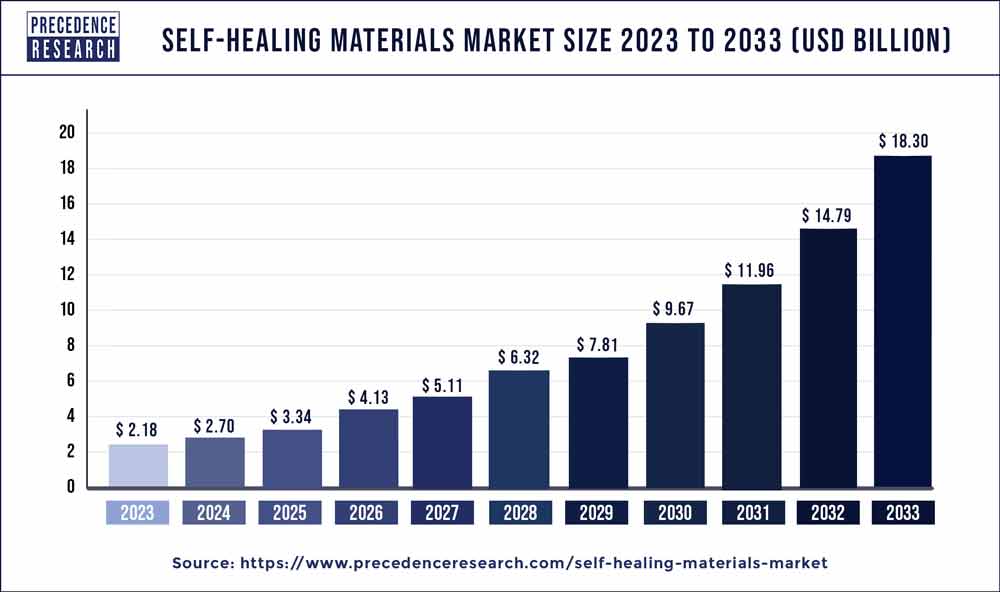The self-healing materials market size was valued at USD 2.18 billion in 2023 and is projected to hit around USD 18.30 billion by 2033 with a CAGR of 23.71% from 2024 to 2033.
Key Points
- North America dominated the market with the largest share in 2023.
- Asia Pacific is expected to witness substantial growth during the forecast period.
- By product type, the polymer segment dominated the market in 2023.
- By product type, the concrete segment shows notable growth during the forecast period.
- By technology type, the encapsulated ascorbic acid segment dominated the market in 2023.
- By technology type, the skin better science segment held a significant share in 2023.
- By application, the microencapsulation segment dominated the market in 2023.
- By application, the shape memory polymers segment is expected to witness significant growth in the market during the forecast period of 2024-2033.

The self-healing materials market has witnessed substantial growth in recent years, driven by advancements in materials science and a growing demand for innovative solutions across various industries. Self-healing materials are designed to autonomously repair damage, extending the lifespan and durability of products, which has garnered significant attention in sectors such as construction, automotive, electronics, and healthcare.
Get a Sample: https://www.precedenceresearch.com/sample/3832
Growth Factors:
Several factors contribute to the growth of the self-healing materials market. The increasing focus on sustainability and the need for durable and long-lasting products have propelled the adoption of self-healing materials. Technological advancements in nanotechnology and polymer chemistry play a crucial role in enhancing the self-healing capabilities of materials, further fueling market growth. Additionally, rising investments in research and development activities to create more efficient and cost-effective self-healing solutions contribute to the expansion of the market.
Self-healing Materials Market Dynamics
Drivers:
The automotive industry stands out as a major driver for the self-healing materials market. The integration of self-healing technologies in vehicle components, such as coatings and polymers, reduces maintenance costs and enhances the overall performance and aesthetics of automobiles. Moreover, the construction sector is embracing self-healing concrete and asphalt, driven by the potential to minimize maintenance and repair expenses over the life of structures.
The electronics industry is another significant driver, as manufacturers seek self-healing materials to improve the reliability and longevity of electronic devices. The ability of these materials to repair minor damages, such as scratches or cracks, in electronic components is particularly appealing to consumers, fostering their adoption in consumer electronics.
Opportunities
Opportunities abound in the self-healing materials market, especially as industries explore novel applications. The healthcare sector presents a promising avenue, with the development of self-healing polymers for medical devices. Additionally, the aerospace industry is actively exploring self-healing materials for aircraft components to enhance safety and reduce maintenance costs. The increasing awareness of environmental concerns also opens doors for sustainable self-healing solutions, aligning with the global push towards eco-friendly technologies.
Challenges:
Despite the promising outlook, the self-healing materials market faces challenges that need addressing. High production costs associated with manufacturing advanced self-healing materials pose a barrier to widespread adoption. Moreover, the scalability of these materials for mass production remains a challenge, hindering their integration into mainstream industries. Additionally, concerns related to the toxicity of certain self-healing materials and their impact on human health and the environment require careful consideration and mitigation strategies.
Read Also: RF Mixers Market Size Will be USD 9.35 Billion by 2033
Recent Developments
- In December 2023, Philadelphia, Drexel University’s College of Engineering presented ‘BioBuild,’ a groundbreaking solution revolutionizing concrete repair. Harnessing the power of living tissue systems, BioBuild integrates reinforcing fibers with concrete-healing bacteria, effectively repairing cracks and enhancing structural durability.
- In October 2023, DuPont launched COASTALUME with U.S. Steel. This is a material specifically designed to withstand coastal environments. It combines the self-healing aspects and strength of U. S. Steel’s GALVALUME and DuPont’s Tedlar PVF film barrier, which can withstand saltwater corrosion, cracking, and UV damage.
Competitive Landscape:
The self-healing materials market is characterized by intense competition, with key players focusing on research and development to gain a competitive edge. Companies are investing in partnerships and collaborations to combine expertise and accelerate innovation. Notable players in the market include [Company A], [Company B], and [Company C], each contributing to the market’s growth through product development and strategic initiatives. The competitive landscape is dynamic, with a constant influx of new entrants bringing novel self-healing solutions to the market.
Self-healing Materials Market Companies
- The Dow Chemical Company
- Covestro AG
- High Impact Technology, LLC
- Huntsman International LLC
- Michelin Group
- MacDermid Autotype Ltd.
- Akzo Nobel N.V.
- Evonik Industries Corporation
- BASF SE
- NEI Corporation
Segment Covered in the Report
By Product
- Polymers
- Ceramics
- Cement
- Asphalt
- Metals
- Fiber-reinforced composites
- Coatings
- Adhesives
- Polymers
- Concrete
By Technology
- Skin Better Science
- Encapsulated Ascorbic Acid Technology
- ferment Filtrate Technology
By Application
- Microencapsulation
- Shape Memory Polymers
- Biological Systems
- Nanotechnology
- Capsule-Based Systems
- Vascular Systems
- Chemical Systems
- Physical Systems
- Autonomic Healing
- Reversible Cross-Linking
By Geography
- North America
- Europe
- Asia-Pacific
- Latin America
- Middle East and Africa
Contact Us:
Mr. Alex
Sales Manager
Call: +1 9197 992 333
Email: sales@precedenceresearch.com
Web: https://www.precedenceresearch.com
Blog: https://www.expresswebwire.com/
Blog: https://www.uswebwire.com/
